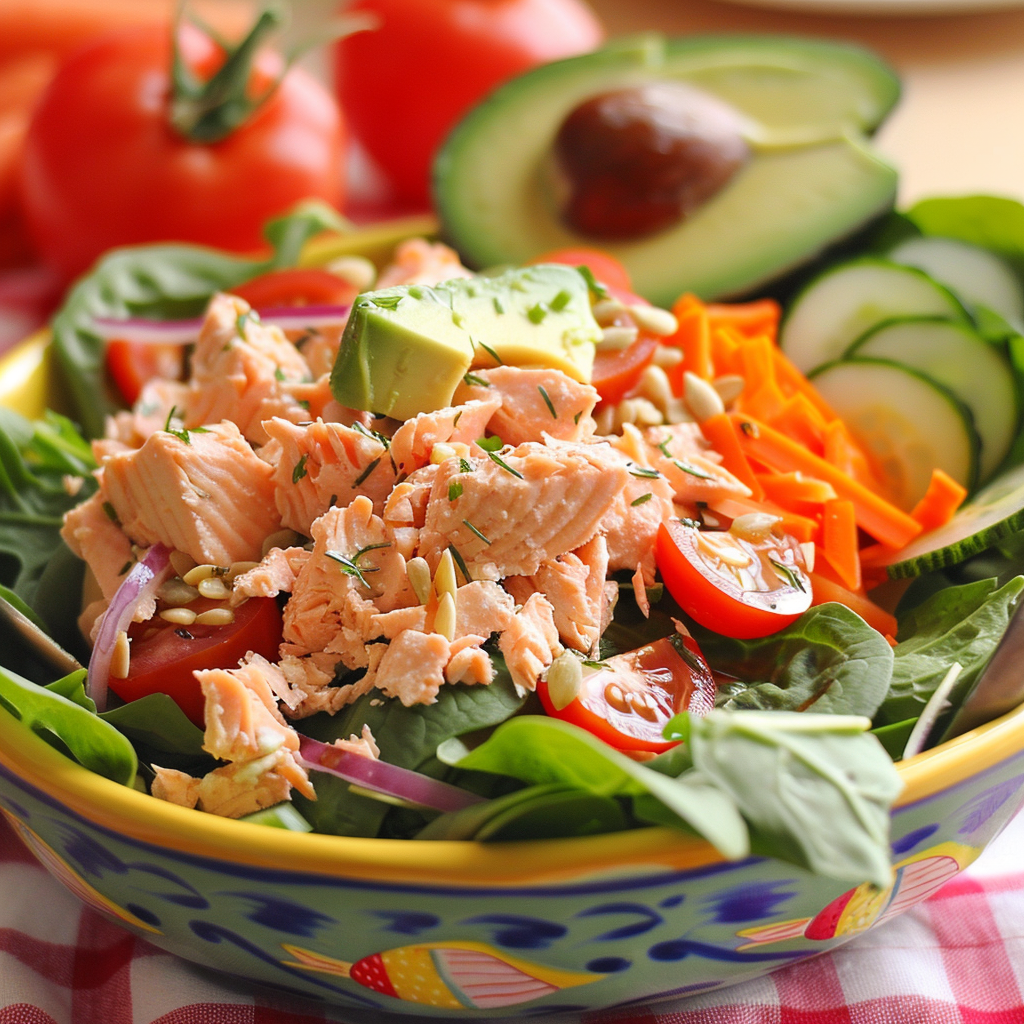Fresh and Flavorful Canned Salmon Salad with Lemon Dill Dressing

Share
Canned Salmon Salad With A Tasty Dill Dressing
This is a very nice meal for lunch or dinner. When you eat a large salad, adding something like salmon makes it pretty filling. Depending on your dietary preferences, this salad is satisfying and packed with nutrients. It's quick to assemble and provides a refreshing, healthy option that's perfect for a light yet substantial meal. The combination of crisp vegetables, creamy avocado, and the richness of wild sockeye salmon creates a delicious blend of flavors that will leave you feeling nourished and satisfied.
Did You Know?
Wild sockeye salmon is not only delicious but also packed with omega-3 fatty acids, which are essential for heart health and brain function. This type of salmon is known for its deep red flesh and rich flavor. Salmon are anadromous, meaning they are born in freshwater, migrate to the ocean, and then return to freshwater to spawn!
Yield: 2 servings
Ingredients:
- 4 cups mixed greens (romaine, spinach, and arugula)
- 1 (6 oz) can wild sockeye salmon, drained
- 1/2 cup cherry tomatoes, halved
- 1/2 cup cucumber, diced
- 1/2 cup red bell pepper, diced
- 1/2 cup grated carrots
- 4 tablespoons red onion, thinly sliced
- 1/2 avocado, sliced
- 4 tablespoons sunflower seeds
Lemon Dill Dressing:
- 4 tablespoons olive oil
- 2 tablespoons lemon juice
- 2 teaspoons Dijon mustard
- 2 teaspoons fresh dill, chopped (or 1 teaspoon dried dill)
- 1 teaspoon honey (optional)
- Salt and pepper to taste
Instructions:
Make Dressing:
In a small bowl, whisk together olive oil, lemon juice, Dijon mustard, fresh dill, honey (if using), salt, and pepper.
Personal Tip: Making the dressing ahead of time allows the flavors to meld. Store in the fridge and give it a good shake before using!
Assemble Salad:
Arrange mixed greens on a plate. Top with salmon, cherry tomatoes, cucumber, red bell pepper, grated carrots, red onion, and avocado.
Personal Tip: Flake the salmon gently to preserve larger chunks for more texture in every bite.
Dress Salad:
Drizzle the lemon dill dressing over the salad and toss gently to coat all ingredients evenly.
Personal Tip: Be careful not to overdress the salad; you can always add more dressing as you toss.
Serve:
Sprinkle with sunflower seeds and enjoy.
Personal Tip: Use as much as you like with sunflower seeds as they are very good for you.
Nutritional Information (Per Serving):
Calories: 350 | Protein: 22g | Carbohydrates: 12g | Fiber: 5g | Net Carbohydrates: 7g | Fat: 25g | Saturated Fat: 4g | Cholesterol: 45mg | Sodium: 400mg | Sugars: 6g | Glycemic Index: Low
Kitchen Tips, Great Ideas, How to Save Money
-
Using Fresh vs. Canned Salmon:
Fresh salmon can provide a richer flavor, but canned salmon is convenient and budget-friendly. Look for wild-caught varieties for better taste and nutrition. -
Bulk Buying:
Purchase pantry staples like olive oil, mustard, and sunflower seeds in bulk to save money. These items have a long shelf life and can be used in many different recipes. -
Homemade Dressing:
Making your own salad dressing is not only more cost-effective but also healthier than store-bought versions. You can control the ingredients and avoid unnecessary preservatives. -
Seasonal Vegetables:
Use vegetables that are in season to get the best flavor and price. Seasonal produce is often fresher and more affordable. -
Cheese Alternatives:
If you want to add cheese, consider crumbled feta or goat cheese. These options complement the flavors of the salmon and vegetables well. -
Batch Cooking:
Prepare larger quantities of the salad ingredients and store them separately in the fridge. This makes it easy to assemble a quick salad for the next few days. -
Reducing Food Waste:
Use any leftover salad ingredients in other recipes. For example, chopped vegetables can be added to wraps, grain bowls, or omelets. -
Flavor Enhancements:
Add a splash of balsamic vinegar or a sprinkle of fresh herbs like parsley or cilantro for an extra burst of flavor. Fresh herbs can elevate the taste of your salad significantly. -
Storage Tips:
Store the dressing separately if you plan to make the salad ahead of time. This keeps the vegetables fresh and crisp until you're ready to eat. -
Cost-Saving Tips:
Look for sales and discounts on fresh produce and other ingredients. Buying in-season and from local farmers' markets can provide high-quality items at lower prices.
Let's Learn About Sockeye Salmon
Sockeye salmon is a rich source of omega-3 fatty acids, essential for heart health. Wild sockeye, caught in the cold waters of the Pacific, is prized for its deep red flesh and robust flavor. However, wild salmon populations face challenges from overfishing and climate change, threatening their sustainability. Farmed salmon, while more affordable, can raise concerns about disease and pollution. Choosing sustainably sourced wild sockeye salmon helps protect the environment and ensures you're getting the best nutritional benefits.


